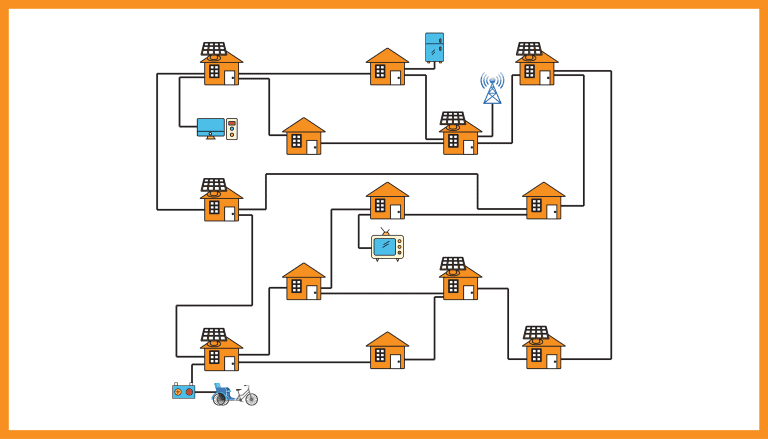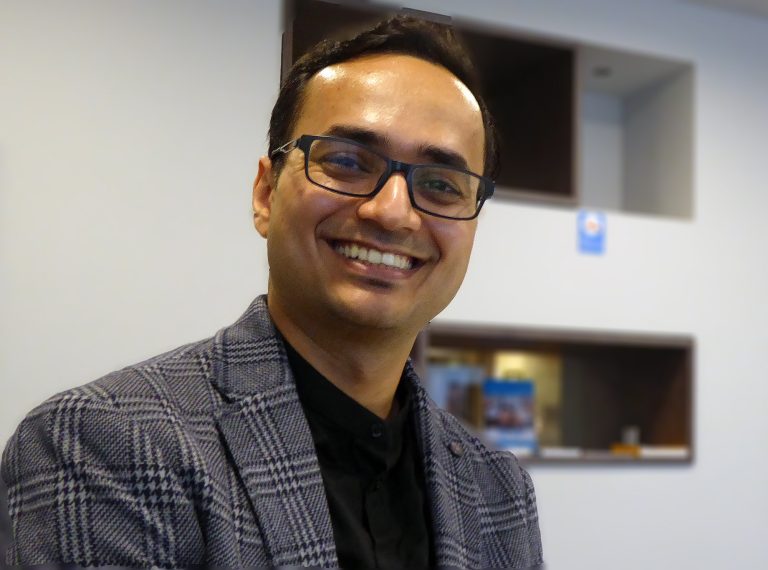Connecting solar home systems in a microgrid improves electricity supply in remote villages. Dr Nishant Narayan wants to enable people to climb the development ladder.
Solar power gets better when shared. (Photo: SolShare)
Working as a hardware design engineer in India, Nishant Narayan (Mumbai, 1986) experienced a growing disconnect between what he was developing – the next generation of electronic toys – and what people really needed.
In India, as in large parts of Africa, many people lacked access to reliable electrical power. There may be a solar panel on the roof connected to a car battery, but power soon runs out. Narayan’s mission became to provide electricity to the nearly one billion people who are currently without. Narayan aligns his efforts with the UN Sustainable Development Goal on affordable and clean energy which states that 13% of the global population lacks access to modern electricity. “It’s important to remember that electrical power is a major enabler of development,” says Narayan. People can use electricity to power their phones and get information. There is light to work or study, and electricity powers productivity by driving pumps or machines for agriculture or small and medium enterprises.
From his hometown of Bangalore, he discovered TU Delft’s Master of Sustainable Energy Technology (SET) and decided to switch from semiconductors to renewable energies. “Delft is brilliant in all sorts of renewable energy”, says Narayan. “But I wanted to focus on small scale solar energy for the poor.” He came to Delft in 2011 with a wish to focus on solar energy.
Two years later, he wrote his thesis on a solar-powered charging station for light electric vehicles. In July 2015 he received a research fellowship from the TU Delft Global Initiative to pursue a PhD in DC (direct current) energy systems. Last week he successfully defended his thesis entitled Solar Home Systems for Improving Electricity Access.
Counter intuitively perhaps, electricity is not an on-off issue. There are several stages in electricity provision. The World Bank has introduced a system of five tiers of electricity supply ranging from a small photovoltaic (PV) panel (3 Watt) for powering a phone or a small LED light (Tier 1) to almost round the clock power in Tier 5 with a maximum load of 2 kW (such as a kettle). At an in-between level (Tier 3) with 200 Watts of solar power and a battery capacity of 1 kWh (five hours of sun), solar home systems can be linked in a microgrid that connects between a couple and dozens of units. The proposed system has in-house systems that could run on 48 Volts DC and interconnections on 350 Volts DC (mostly because the cables may be thinner, and losses in power exchange smaller).


A solar microgrid has numerous advantages compared to stand-alone systems, argues Narayan: solar systems may be smaller if they are interconnected; DC power architecture enables easy power exchange; excess energy may be shared – not wasted; the microgrid is easily adaptable and future-proof; and finally, the higher amount of available power enables the productive use of energy for small businesses.
AC (alternating current) may be the standard for large power networks in industrial regions, but for small solar-based microgrids DC is a more logical choice because both generation and consumption occur in DC.
However, fully decentralised solar-home-system based microgrids do not yet exist, says Narayan. The closest system is made by the prize-winning company SolShare which pioneers the peer-to-peer trading of solar energy in Bangladesh. The company is a start-up from TU Berlin that aims to build power grids bottom-up for the poorest. However, Narayan points out, SolShare systems work at very low voltage and power levels, which makes it less future-proof.


Narayan expects that a first microgrid of solar home systems will be built as a living lab on some tropical campus. He will be involved in the further development of energy access for the poor in his function as Programme Lead for Energy Access at the TU Delft Global Initiative.
How can this technology give poor people access to electricity? According to Roel Kamerling, programme developer with TU Delft Global Initiative, the main merit of Narayan’s research is that it gives a roadmap of how to build a grid bottom-up and still keep it compatible with a connection to the main grid if it ever arrives.
In a workshop during the Global Impact Day, the World Bank and several companies said that Narayan’s presentation had given them a better view of both the problem (of power access for the poor) and of the opportunities.
As for the roll-out, Solarworks!’ scheme of pay-as-you-go, may solve the problem of investing in equipment with small monthly payments using mobile money. Solarworks! is one of the partners in the Re-thinking solar energy project. Kamerling concludes: “The value of this study is that it gives direction and grip for all parties needed in providing power to the poor.”
- Nishant Narayan, Solar home systems for improving electricity access: An off-grid solar perspective towards achieving universal electrification, PhD supervisors Professor Pavel Bauer and Professor Miro Zeman (EEMCS/EWI), 20 November 2019.
Do you have a question or comment about this article?
j.w.wassink@tudelft.nl


Comments are closed.